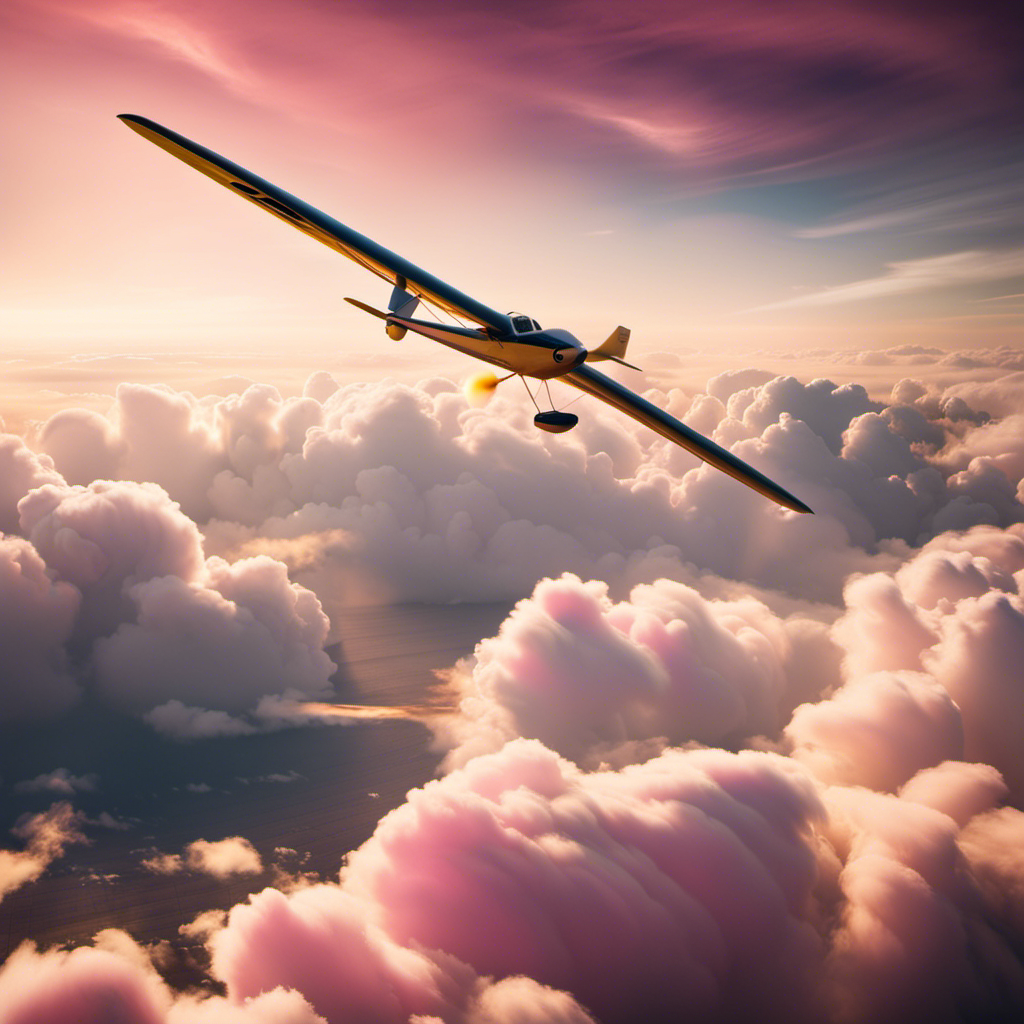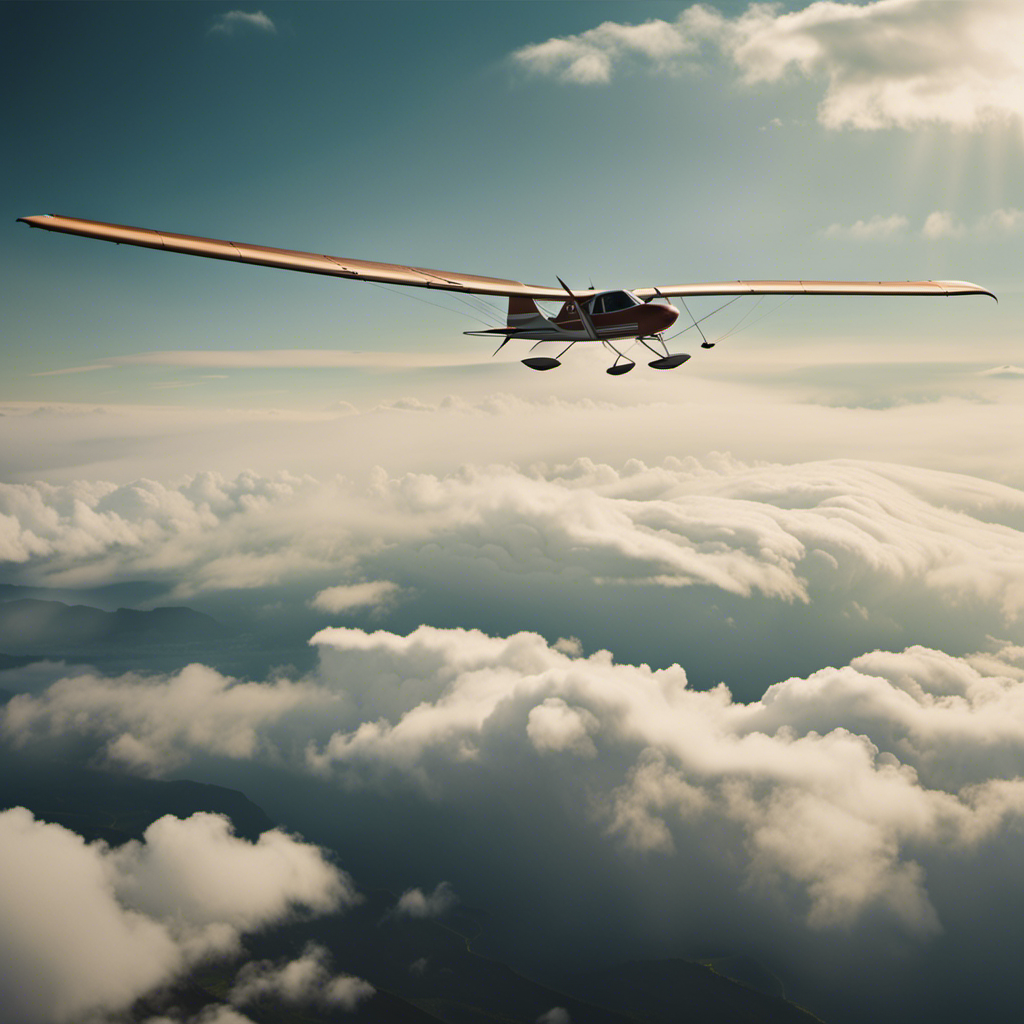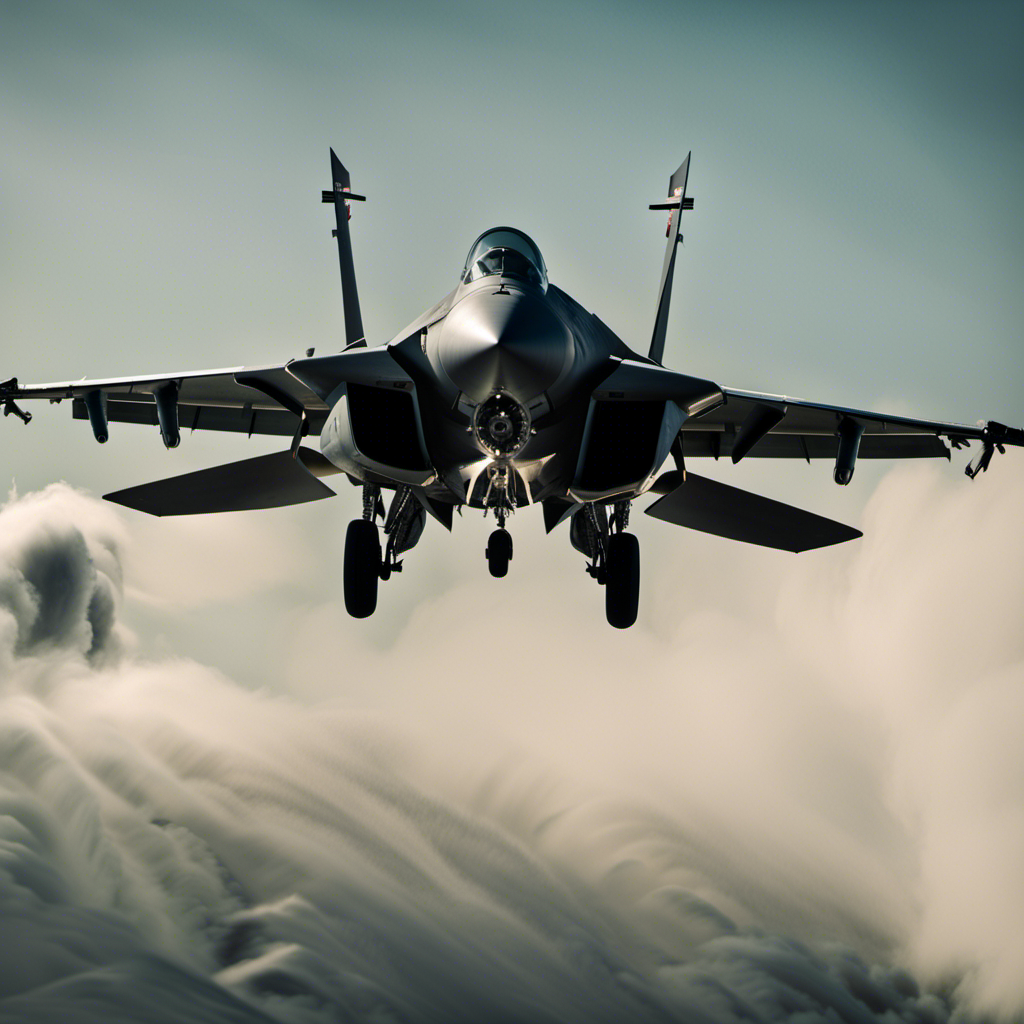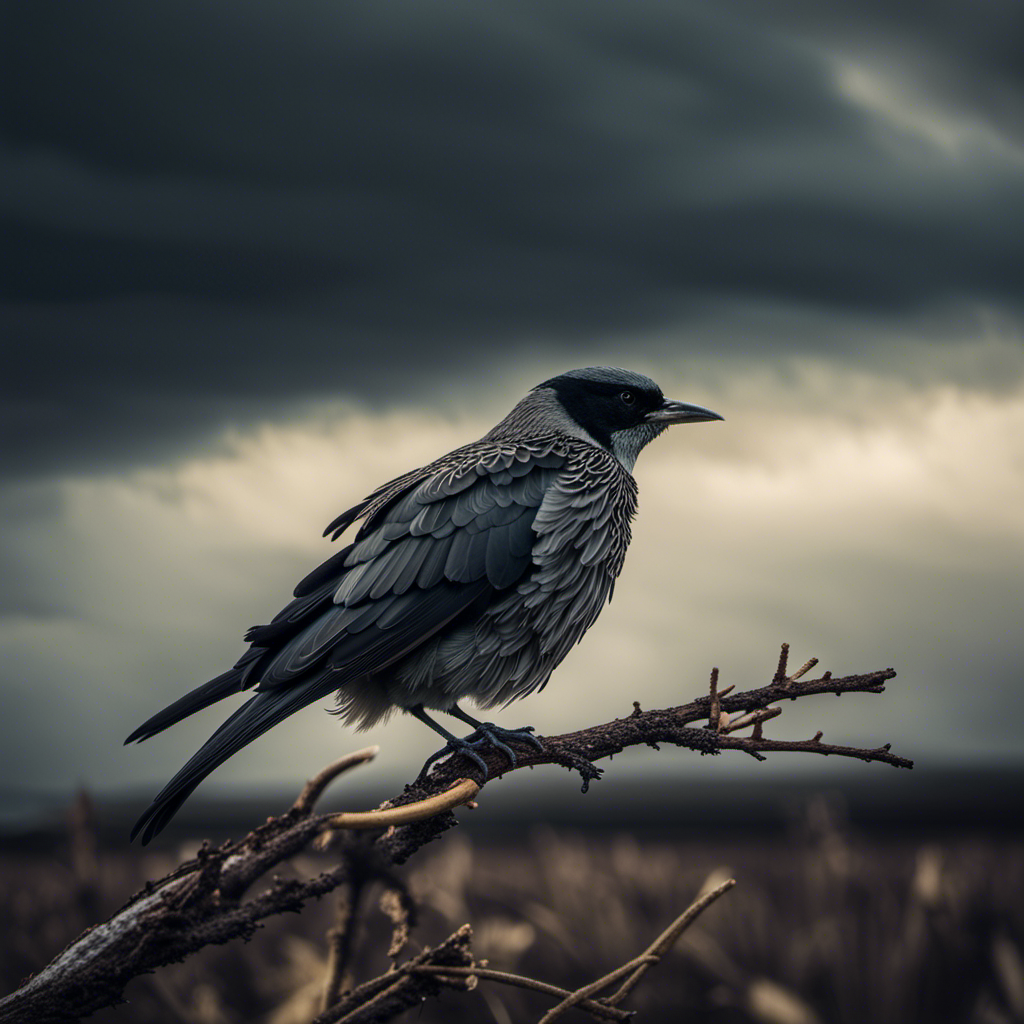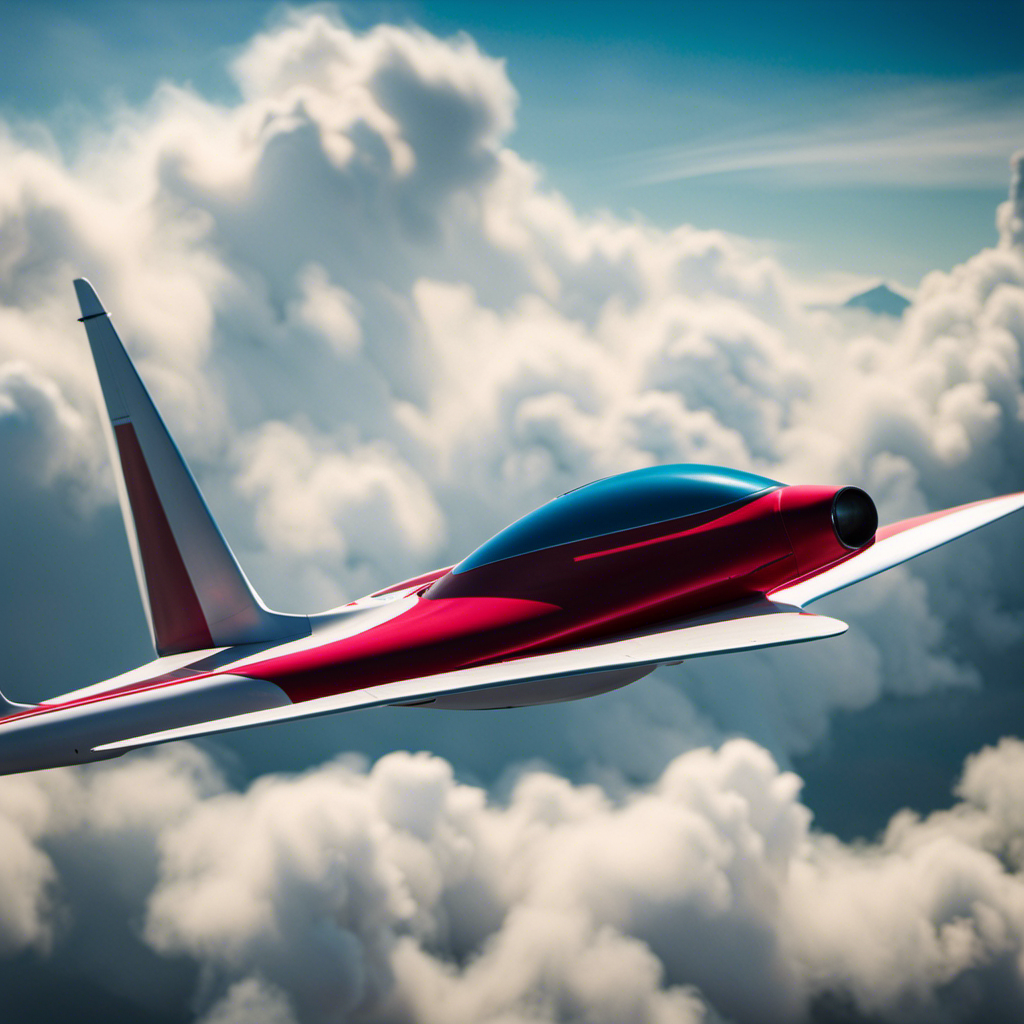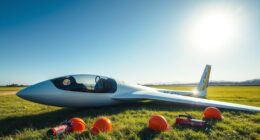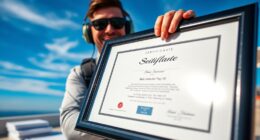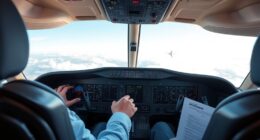Have you ever thought about how long a glider can stay in the air? Let me tell you, the answer might surprise you.
Glider flight is a fascinating blend of skill, technology, and weather conditions. In this article, we will explore the basics of glider flight, the role of weather, and the importance of skilled piloting.
We’ll also delve into glider design and performance, safety considerations, and tips for maximizing flight duration.
So, buckle up and get ready to soar to new heights in the world of glider flight!
Key Takeaways
- Good communication and adherence to safety considerations are essential for a safe and enjoyable glider flight.
- Implementing strategies to optimize efficiency and conserve energy can maximize flight duration.
- Exploring famous glider flight locations around the world provides opportunities for remarkable flight records and training.
- Advancements in glider technology, such as the use of solar power and innovations in materials and aerodynamics, are shaping the future of extended flight duration possibilities.
Understanding the Basics of Glider Flight
So, how long can you stay up in a glider?
To understand the answer to this question, we need to delve into the basics of glider flight.
Glider aerodynamics plays a crucial role in determining how long a glider can stay aloft. The key to glider flight lies in lift generation.
Lift is created by the glider’s wings as they move through the air. The shape of the wings, known as the airfoil, is designed to create a pressure difference between the upper and lower surfaces. This pressure difference generates lift, allowing the glider to overcome gravity and stay airborne.
Understanding the principles of lift generation is fundamental to maximizing glider flight time.
Now, let’s explore the role of weather conditions in prolonging our time in the sky.
The Role of Weather Conditions
The weather conditions greatly affect how much time can be spent soaring in a glider. Wind patterns play a crucial role in determining the duration of a glider flight. Strong winds can provide the necessary lift for the glider to stay airborne, allowing for longer flights. Conversely, calm or inconsistent winds can make it difficult to maintain altitude, resulting in shorter flight times.
Additionally, the temperature also affects glider flight. Warm air tends to rise, creating thermals that glider pilots can use to gain altitude and extend their flight duration. On the other hand, cold air can limit the development of thermals, reducing the time spent soaring.
Understanding these wind patterns and temperature effects is essential for maximizing flight time in a glider. Skilled piloting is crucial to navigating and utilizing these weather conditions effectively.
The Importance of Skilled Piloting
To maximize your flight time in a glider, it’s crucial that you possess skilled piloting abilities. Utilizing effective piloting techniques and implementing proper risk management strategies are key factors in extending your time in the air. By understanding the aerodynamics of a glider and employing the right maneuvers, you can optimize your flight performance and increase your chances of staying aloft for longer periods.
Additionally, being proficient in assessing and managing potential risks during flight is essential for maintaining safety and prolonging your time in the glider. By continuously refining your piloting skills and employing sound risk management practices, you can maximize your flight time and enjoy the freedom of soaring through the skies.
Transitioning into the subsequent section about ‘glider design and performance,’ it is important to consider how these factors play a role in enhancing your flight experience.
Glider Design and Performance
By understanding how glider design and performance affect your flight experience, you can optimize your time in the air.
Glider aerodynamics play a crucial role in determining how well a glider performs. The shape of the wings, the angle of attack, and the overall design all affect the glider’s efficiency and ability to stay aloft.
Glider performance analysis involves studying various factors like glide ratio, sink rate, and stall speed to assess the capabilities of a glider. By analyzing these factors, pilots can choose a glider that suits their flying style and goals.
Additionally, understanding glider design and performance can help pilots make adjustments during flight to maximize their endurance and stay up in the air for longer periods of time.
This knowledge sets the stage for investigating the impact of ballast and water ballast systems.
The Impact of Ballast and Water Ballast Systems
Understanding how ballast and water ballast systems affect the performance of a glider is essential for optimizing flight endurance and capabilities. The impact of weight distribution plays a crucial role in determining the glider’s stability and handling characteristics.
When ballast is added to the glider, it increases its weight, which can improve its overall performance, especially in windy conditions. By adjusting the weight distribution, pilots can optimize the glider’s center of gravity, allowing for better control and maneuverability.
However, it is important to note that excessive weight can negatively affect the glider’s climb rate and glide ratio. Therefore, it is essential to carefully balance the amount of ballast used to achieve the desired performance.
The effects of ballast on glider performance are a critical consideration for pilots aiming to break records and achieve remarkable flight durations.
Records and Achievements in Glider Flight Duration
Achieving remarkable flight durations in glider records and achievements requires careful consideration of weight distribution and optimizing the center of gravity. Glider flight techniques and strategies for staying aloft play a crucial role in achieving extended flight times. Pilots employ a range of tactics, such as finding the most favorable atmospheric conditions, utilizing ridge lift and thermals, and employing efficient soaring techniques. Another important factor is the design and construction of the glider itself, with manufacturers continuously working on improving aerodynamics and reducing drag. Additionally, pilots must be skilled in energy management, making precise adjustments to speed and altitude to maximize flight time. By employing these strategies and techniques, pilots have achieved incredible flight durations, with some records exceeding 1,000 kilometers and lasting over 14 hours.
| Glider Flight Techniques | Strategies for Staying Aloft |
|---|---|
| Utilizing ridge lift | Finding favorable atmospheric conditions |
| Soaring in thermals | Employing efficient soaring techniques |
| Energy management | Making precise adjustments to speed and altitude |
When attempting extended flights, safety considerations are of utmost importance.
Safety Considerations for Extended Flights
When attempting extended flights, it’s crucial to prioritize safety. As a pilot, I understand the importance of being prepared for any situation that may arise during a glider flight. Here are some safety considerations to keep in mind:
-
Pilot Fatigue: It’s essential to be well-rested before embarking on a long glider flight. Fatigue can impair judgment and reaction time, increasing the risk of accidents.
-
Emergency Procedures: Familiarize yourself with the emergency procedures specific to your glider. Knowing how to handle emergencies such as canopy malfunctions or in-flight incidents is vital for ensuring a safe flight.
-
Communication: Maintain good communication with ground crew and air traffic control. Regularly update them on your position and intentions, enabling them to assist you in case of an emergency.
By adhering to these safety considerations, pilots can minimize risks and ensure a safe and enjoyable glider flight.
Now, let’s explore some tips for maximizing glider flight duration.
Tips for Maximizing Glider Flight Duration
To maximize your flight duration in a glider, it’s important to implement strategies that optimize efficiency and conserve energy.
One key strategy is to seek out thermals, which are columns of rising air that can provide lift and keep you aloft for longer periods of time. By flying in circles within a thermal, you can gain altitude and prolong your flight.
Additionally, maintaining proper weight and balance in the glider is crucial. Make sure to distribute the weight evenly and adjust the ballast as necessary to ensure stability and reduce drag.
By carefully managing these factors, you can extend your flight duration and enjoy the freedom of soaring through the sky.
Now, let’s explore famous glider flight locations around the world.
Famous Glider Flight Locations Around the World
After learning about the tips for maximizing glider flight duration, it is fascinating to explore the famous glider flight locations around the world. These locations have witnessed remarkable glider flight records and serve as training grounds for aspiring glider pilots.
One such renowned location is Omarama in New Zealand, known for its favorable weather conditions and stunning landscapes.
The Great Basin Desert in Nevada, USA, is also famous for its long, sustained thermals, attracting glider enthusiasts from all over the world.
Additionally, the French Alps offer breathtaking mountain ranges, ideal for challenging and exhilarating glider flights.
These famous glider flight locations not only provide incredible experiences but also serve as important hubs for glider flight training programs, allowing aspiring pilots to learn from the best.
As we delve into the future of glider technology and flight duration, let’s explore the advancements that will shape the limitless possibilities of glider flight.
The Future of Glider Technology and Flight Duration
As we look ahead, advancements in glider technology will shape the limitless possibilities for flight duration. The future of glider technology holds great promise, particularly in the area of renewable energy. Innovations in materials, aerodynamics, and energy storage will allow gliders to stay aloft for longer periods of time, providing a more sustainable and efficient form of flight. One exciting area of development is the use of solar power to generate electricity and extend flight duration. By incorporating solar panels onto the wings and fuselage of gliders, pilots can harness the power of the sun to recharge batteries and power onboard systems. This not only reduces the reliance on traditional fuel sources but also opens up new opportunities for long-duration flights. With these future advancements, gliders will be able to explore the skies for extended periods, revolutionizing the possibilities of flight.
| Advancements | Renewable Energy |
|---|---|
| Materials | Solar Power |
| Aerodynamics | |
| Energy Storage |
Frequently Asked Questions
Are gliders safe for extended flights?
Yes, gliders are safe for extended flights due to rigorous safety measures. The pilot’s endurance plays a crucial role in long flights, as they need to maintain focus and physical stamina throughout the journey.
What are some tips for staying comfortable during long glider flights?
To stay comfortable during long glider flights, follow these tips: wear comfortable clothing and footwear, use a cushion for support, stay hydrated, and take breaks to stretch. To prevent motion sickness, focus on distant objects and avoid reading or looking down.
How do gliders handle different weather conditions?
Glider performance is influenced by weather conditions, particularly wind. Wind speed and direction can affect the glider’s ability to maintain altitude, climb, or descend. Understanding these factors is crucial for safe and efficient glider flight.
Are there any famous glider flight records?
Famous glider pilots have set numerous flight records in glider flight competitions. These records showcase the remarkable endurance and skill required to stay airborne for extended periods, pushing the limits of glider flight.
What advancements are being made in glider technology to increase flight duration?
Solar powered gliders are seeing advancements in aerodynamic improvements to increase flight duration. These innovations include streamlined designs, lightweight materials, and efficient solar panels. These improvements are crucial for achieving longer flight times and reducing reliance on traditional power sources.
Conclusion
In conclusion, the possibilities of staying up in a glider seem limitless. With the right skills, weather conditions, and design, one can soar through the skies for what feels like an eternity.
The thrill of defying gravity, the breathtaking views, and the sheer joy of gliding through the air make it an experience like no other.
So, if you’re looking for an adventure that will leave you exhilarated and in awe, look no further than glider flight. It’s an experience that will truly take your breath away.
Orion, better known as “Jetstream,” is the voice that brings the stories of the skies to life. His fascination with aviation began at a young age, sparked by his father’s tales of flying and adventure. Orion’s journey into the world of gliding was serendipitous, and from the moment he took his first glider flight, he knew he had found his calling.
